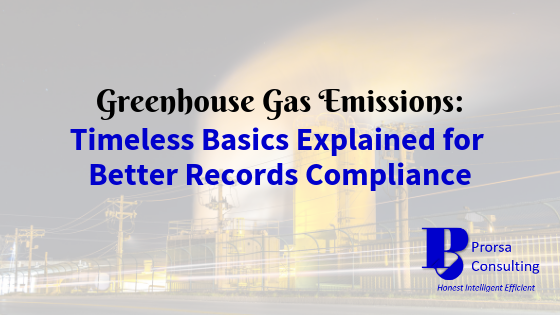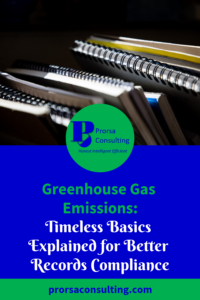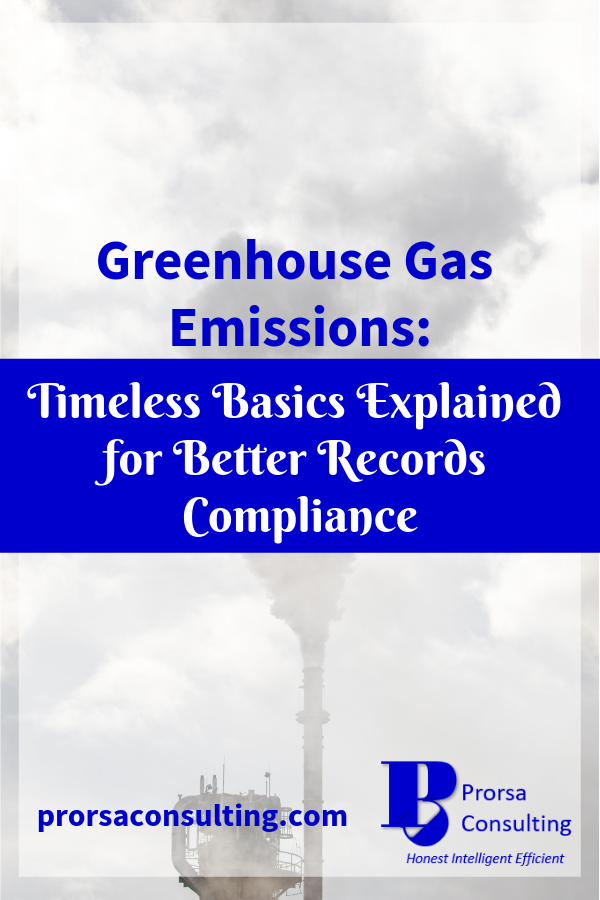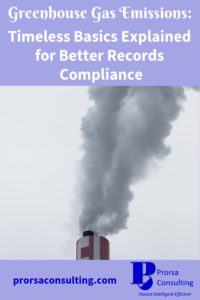Greenhouse Gas Emissions: Timeless Basics Explained for Better Records Compliance
By : Admin -

Each year numerous organizations report their greenhouse gas emissions to U.S. Environmental Protection Agency (EPA) in compliance with the Greenhouse Gas Mandatory Reporting Rule (GHG MRR) found at 40 CFR §98.
In 2017, almost 3 billion metric tons of carbon dioxide equivalent emissions were reported in total, according to EPA’s Facility Level Information on Greenhouse Gases Tool, or FLIGHT (data reported as of 8/19/2018).
Given the amount of greenhouse gas emissions information reported, recordkeeping can present some challenges. Moreover, a facility’s process, equipment, and material changes may increase opportunities for noncompliance.
Organizations should get back to the basics to improve greenhouse gas emissions records compliance. Continue reading to refresh your memory on the general records maintenance required by the GHG MRR.
Disclaimer: Please be aware that this blog post may contain affiliate links and any purchases made through such links will result in a small commission for Prorsa Consulting (at no extra cost for you). Feel free to visit our Disclosure of Material Connection page for more information.
Greenhouse Gas Emissions Records Compliance Basics – General Information
Facilities covered by the GHG MRR must engage in recordkeeping activities as outlined in the regulation. As such, the following requirements apply generally to all facilities subject to the rule:
- All required records must be kept for a minimum of 3 years after the submittal of the Greenhouse Gas Annual Report to which the records pertain.
- Input Verification Tool (IVT) records have to be maintained for at least 5 years following the Greenhouse Gas Annual Report submission for which the IVT records were generated.
- Records can exist in either hardcopy or electronic format.
- Regardless of the format, records must be made available to EPA upon request.
Greenhouse Gas Emissions Records Compliance Basics – What Records Are Covered?
Various records are subject to the recordkeeping requirements established in the GHG MRR. Consequently, reporting sites must maintain the following records, at a minimum:
- A listing of the units, operations, processes, and activities that had greenhouse gas emissions calculated for them.
- The information used in the actual greenhouse gas calculations for each unit, operation, process, and activity. This requirement includes items such as:
-
- Greenhouse gas calculations and the calculation methods utilized;
- IVT data downloaded from the Electronic Greenhouse Gas Reporting Tool, or e-GGRT;
- Results of analytical testing used to create facility-specific emission factors;
- Results of fuel analyses for high heat value, carbon content, etc.;
- Any operating or process data utilized in the greenhouse gas emissions computations, such as production amounts, inventory records, sales data, etc.
- The Greenhouse Gas Annual Reports submitted to EPA.
- Records of each missing data event detailing the event cause and mitigation actions to address monitoring equipment malfunctions.
- The Greenhouse Gas Monitoring Plan, detailing the following:
-
- Responsible individuals for greenhouse gas data collection
- The data collection methods utilized
- Practices to ensure quality assured greenhouse gas data from all instrumentation utilized to provide information to comply with the GHG MRR.
- Certification and quality assurance testing results for instruments used to provide information for compliance.
- Records of maintenance for instrumentation used to satisfy outlined requirements.
- Any other record specified for recordkeeping under each GHG MRR subpart applicable to the reporting facility.

Image: By Matt Artz at Unsplash.com.
Greenhouse Gas Emissions Records Compliance Basics – Compliance Strategies
The GHG MRR give facilities flexibility to design their own greenhouse gas data recordkeeping practices, as long as they comply with regulatory requirements. However, sites should consider the following when reviewing their information management practices with regards to greenhouse gas emissions records:
- Retrieving past records can pose a daunting task when data records do not reside in a centralized location. Keep as many records together as possible, organizing them by report year. Moreover, ensure key personnel, and backup staff as needed, have ready access to the required greenhouse gas emissions data.
- When supporting records reside across different database systems, make sure key personnel know which system(s) to access for exports of official data. Remember, the Greenhouse Gas Annual Report should be reproducible, meaning individuals should be able to pull the same official data used in the said report at some future time from the database(s).
- Finish up the facility’s greenhouse gas annual reporting each year by informally verifying the identification and incorporation of all required records into the site’s chosen information management system or process.
- Ensure GHG MRR records compliance gets reviewed periodically during regularly scheduled audits and internal inspections.
- Include a description of the site’s recordkeeping practices as part of the Greenhouse Gas Monitoring Plan to ensure a standardized process in the event of personnel changes.

Final Thoughts
Recordkeeping for the GHG MRR, while not hard, can still pose a noncompliance risk to a facility if not implemented correctly. Nonetheless, a basic grasp of the requirements and a little strategic planning can go a long way to ensuring your greenhouse gas emissions records meet or exceed the standard.
Prorsa Consulting prides itself on offering Honest Efficient Intelligent environmental and safety services to help businesses discover and reach their EHS goals.
You can find more information concerning our offerings on the Services page. Feel free to email contact@prorsaconsulting.com with questions.
We encourage your feedback on this blog’s content. Be sure to like and/or share below. You can also give us your feedback via our Contact Us page.
Also, don’t forget to follow Prorsa Consulting on LinkedIn, Pinterest, and Twitter!
Have you subscribed to the Prorsa Consulting Newsletter? If not, be sure to take the opportunity to signup below. In addition to the newsletter providing useful exclusive content, you also gain access to our Free Resources area and all the tools, templates, and presentations in the library. So, don’t wait. Go ahead and subscribe today!


